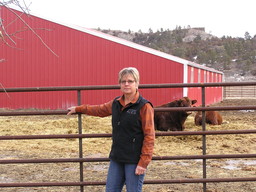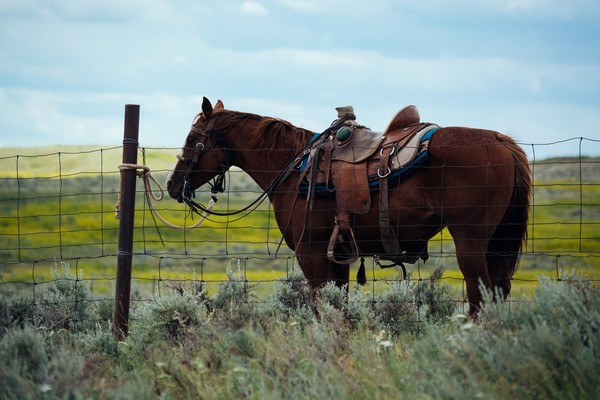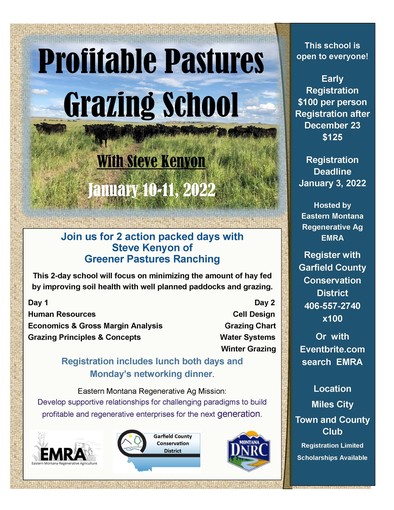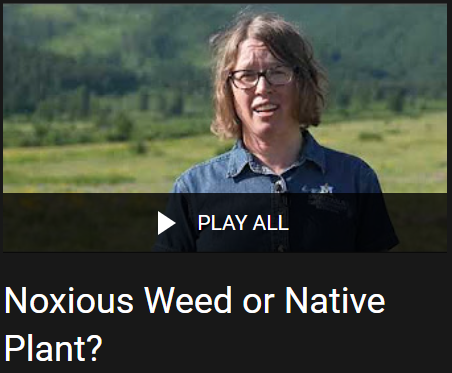
Meet the Chair of the Montana Rangeland Resources Committee!
Diane Ahlgren – Rangeland Resource Committee Chair
Hello from Garfield and Petroleum Counties in Central Montana, or as my husband calls it, "God's country." A brief history of our story: my husband Skip, and I have been fortunate to have many opportunities come our way, and this has allowed us to work hard and put together a “first generation” ranch. Skip was raised on a generational ranch at Grass Range and my family worked and ranched in this area for many years, so neither of us are very far from home. We are proud to produce Red Angus cattle on a mix of private, Bureau of Land Management, and state rangeland with annual average rainfall of 12 inches. (This year less than 5”!) Because water quality and quantity is low, we have installed about 20 miles of stock water pipelines and tanks that benefit both the cows and wildlife. Various cost share programs have been great help with these and other improvements, allowing us to use our matching labor and funds to accomplish more, quicker.
Because of the opportunities that came our way, we have chosen to pass some of our land along to a nephew and his family. They leased part of our place for a period of time and have now purchased that part at what we hope is a feasible agricultural value. We are proud of them for wanting to pursue this line of work where sometimes the only reward is the culture and lifestyle. We have felt it was worthwhile, and living in a small, agricultural community has its own rewards.
I was appointed to the Rangeland Resource Committee (RRC) about 15 years ago and it has been a rewarding experience. Attending the many tours, events, and meetings around the state has afforded me a new view and appreciation of innovative producers who do a wonderful job of producing in less-than-ideal conditions but with consideration for conservation and sustainability for the long term. One of the best projects the RRC has initiated, in my opinion, has been the Working Lands Internship Program. As a host family, we have enjoyed an awesome group of smart, hardworking, dedicated, personable young people that reinforce our hope for the future of our industry and society.
I am also the RRC representative on the Montana Sage Grouse Oversight Team (MSGOT) since its inception in 2015. This has been an intense learning experience but has offered an opportunity to represent the private landowner, rangeland, and grazing viewpoints in sage grouse discussions.
Great staff, agency and entity support, and fellow committee members whom I deeply admire, have made the RRC a fulfilling experience.
I will end with a piece of encouragement to our fellow producers, and all who are affected by, and enjoy the great Montana rangeland, to never stop learning, promoting, and sustaining one of Montana's greatest resources. Wishing you all a Happy, Healthy, and Prosperous New Year.
Visit the Montana Rangeland Resources Committee website, here!
|

Science to Action: Takeaways from Intermountain West Joint Venture's "Storing Carbon in Sagebrush Rangelands" Report
By: Becca Aceto, 11/23/2021
Carbon sequestration is a topic circulating widely throughout the conservation community. Rangelands are coming into the carbon spotlight due to their sweeping extent and because they store relatively more carbon in soils than forests. The importance of keeping carbon out of the atmosphere is widely understood, but breaking down knowledge on how to protect carbon already stored in our ecosystems into actionable practices can be more difficult. Through the Storing Carbon in Sagebrush Rangelands report and companion resources, the Intermountain West Joint Venture (IWJV) aims to translate this science to an applicable scale for land managers and others across western rangelands.
Mariah McIntosh is a Technical Transfer Specialist with the IWJV and authored the full Storing Carbon in Sagebrush Rangelands report. “Understanding the science behind carbon storage in rangelands will be paramount when using targeted management practices to protect critical carbon stored in soils,” she says.
Read more, here!
Year-Round Grazing School- Profitable Pastures Open for Registration
 |
|
Eastern Montana Regenerative Ag along with DNRC and Garfield County Conservation District are hosting a two-day school focusing on profitable pastures and year-round grazing with Steve Kenyon of Greener Pastures custom grazing. With improved paddocks, grazing management, and soil health, the grazing season can be extended, reducing reliance on fed hay.
Registration includes lunch both days and a networking dinner on Monday evening.
Registration is limited to the first 100 people.
Register here!
|

MT Wheat & Barley and MT Pulse Crop Committees to release "Bone Dry" documentary looking back at the 2021 growing season
On December 7th, 2021, the Montana Wheat & Barley Committee, Montana Pulse Crops Commitee, and AgriStudios premiered a 25-minute documentary, called "Bone Dry- Farming Across Montana in 2021."
The documentary “Bone Dry” features seven producers and ag professionals from across Montana and is designed to give viewers an in-depth look at the trials and tribulations these families faced during the 2021 growing season.
“What started as simple crop updates for our partners around the world, quickly turned into a human-interest story on the very real challenges that farmers were facing due to the severe drought,” said Cassidy Marn, Executive Vice President of the Montana Wheat and Barley Committee. “These growers willingly take on the risk and seed into the unknown each year, ultimately just hoping for the best.”
"The resilience of our farmers here in Montana is extraordinary," said Christy Clark, Acting Director for Montana Department of Agriculture. "I'm thrilled that we can share some of their stories with people across the globe through this feature film made possible by checkoff dollars."
The documentary can be viewed on YouTube, or by clicking the photo, above.
|

MSU Extension Weed Post
Noxious Weed or Native Plant?
Join the MSU Extension team in comparing identifying features of noxious weed and native plant look-alike pairs with a series of short 2-3 minute videos! More videos will be coming soon.
Watch the series, here!
|
 |
Departments of the Interior, Agriculture and Homeland Security Jointly Establish New Wildland Fire Mitigation and Management Commission
WASHINGTON — The Departments of the Interior, Agriculture and Homeland Security Federal Emergency Management Agency (FEMA) today announced the establishment of a new Wildland Fire Mitigation and Management Commission. Establishing this Commission fulfills a key provision of the Bipartisan Infrastructure Law and represents a critical step in combating the nation’s wildfire crisis and improving resilience in America’s landscapes.
The Commission is tasked with recommending federal policies and strategies to more effectively prevent, mitigate, suppress and manage wildland fires, including the rehabilitation of land affected from wildland fires. It will include representation from federal, state, Tribal, county and municipal governments as well as non-governmental stakeholders from private industry. Through a coordinated effort, the Commission will deliver a report to Congress with practical policy recommendations one year from the first meeting. In addition, the Commission will outline a strategy to cost effectively meet aerial firefighting equipment needs through 2030.
The work of the Commission will build on existing interagency federal efforts such as the Wildland Fire Leadership Council and the White House Wildfire Resilience Interagency Working Group and will continue to pursue a whole-of-government approach to wildfire risk reduction and resilience.
 |
The Bureau of Land Management Begins Evaluation of Plans for Sage-Grouse Conservation
In order to protect the long-term health of sage-grouse populations, review new science and comply with court direction, the Bureau of Land Management is beginning a process to consider updates to the range-wide management plans for sagebrush habitat adopted in 2015 and amended in 2019. More than 70 resource management plans currently guide habitat conservation and restoration on 67 million acres of greater sage-grouse habitat the bureau manages in 10 Western states.
Safeguarding sagebrush habitat is considered essential to the long-term health of sage-grouse populations as well as more than 350 other species, which continue to experience pressure from development and a variety of factors including invasive grasses, wildfire and drought exacerbated by climate change. In 2015, the U.S. Fish and Wildlife Service cited the protections provided by conservation efforts in the federal land management plans, from states and from other federal, state and private parties, to determine that listing the greater sage-grouse to secure Endangered Species Act protections was not warranted.
“The BLM is committed to reversing long-term downward trends in sage-grouse populations and habitats in a manner that fulfills our multiple-use and sustained yield mission and meets the needs of Western communities,” said BLM Director Tracy Stone-Manning. “We remain dedicated to working closely with states, local governments, Tribes and other partners who have worked in a collaborative and bipartisan fashion for more than a decade toward sustainable and balanced management of sagebrush habitat.”
In its review, the BLM will examine new scientific information, including the effects of stressors like climate change, to assess what management actions may best support sagebrush habitat conservation and restoration on public lands to benefit sage-grouse, as well as the people who rely on this landscape to support their livelihoods and traditions. A related effort to evaluate the proposed withdrawal of public and Forest System lands in sagebrush focal areas from mineral location and entry is already underway.
“The 2015 plans established a solid foundation, but actions during the previous administration kept those plans from being put into action,” Stone-Manning said. “As we move to build upon the earlier plans, we are asking whether there are other steps we should take given new science to improve outcomes for sage-grouse and also for people in communities across the west who rely on a healthy sagebrush steppe.”
Information on how to comment and relevant documents can be found here: https://eplanning.blm.gov/eplanning-ui/project/2016719/510.
Reminder: NRCS Accepting Applications for the Agricultural Conservation Easement Program in Montana
BOZEMAN, Mont., November 16, 2021 – The USDA Natural Resources Conservation Service in Montana is accepting applications for the Agricultural Conservation Easement Program (ACEP) Agricultural Land Easement (ALE) enrollment option. While NRCS accepts easement applications year-round, applications for the current funding cycle must be submitted by January 28, 2022.
To learn about ACEP-ALE and other technical and financial assistance available through NRCS, call your local USDA Service Center or visit www.mt.nrcs.usda.gov.
Contact: Allen Persinger, 406-587-6873
 A New Way to Predict Grazing Cattle Weight Gain on Rangelands From Satellite Imagery
WASHINGTON, December 15, 2021 – USDA's Agricultural Research Service (ARS) developed a unique approach to using satellite imagery to predict cattle weight gain on rangelands. By fusing multiple images over a period of time, scientists were able to monitor how forage quality changes over space and time in rangelands within the shortgrass steppe, and how this relates to the weight gain of free-ranging cattle throughout the summer grazing season.
Managing the grazing season in rangelands can be challenging due to high variability in temperature and rainfall over time. From a manager's perspective, it is essential to know when and where forage production and quality are changing to optimize free-range livestock weight gain and meet other environmental objectives. This is not just about chasing forage quantity (total amount of vegetation biomass); it is also about looking for the highest-quality forage throughout the season.
"This study is probably the first-time high-quality datasets have been used to predict cattle weight gain directly from satellite imagery," said Sean Kearney, Post Doc Research Associate in Fort Collins, CO.
In the study published in Ecological Applications, scientists used the satellite images, along with field observations from 40 different pastures grazed over a period of 10 years, to predict the performance of cattle grazing in Eastern Colorado throughout the summer season. The study site, the Central Plains Experimental Range, is a Long-Term Agroecosystem Research (LTAR) network location.
Learn more, here!
USDA Provides Additional Pandemic Assistance to Hog Producers
| |
|
WASHINGTON, Dec. 13, 2021— The U.S. Department of Agriculture (USDA) announced a new program to assist hog producers who sold hogs through a negotiated sale during the period in which these producers faced the greatest reduction in market prices due to the COVID-19 pandemic. The Spot Market Hog Pandemic Program (SMHPP) is part of USDA’s Pandemic Assistance for Producers initiative and addresses gaps in previous assistance for hog producers. USDA’s Farm Service Agency (FSA) will accept applications Dec. 15, 2021 through Feb. 25, 2022.
Learn more, here!
|
FYI: National Water & Climate Center Webpages Have Moved
Webpages for the National Water & Climate Center have moved to a different address, and many applications hosted on our former www.wcc.nrcs address will no longer be available.
Visit the new homepage to update any links you have for our products, such as:
MSU Extension to Host Cropping Seminars Jan. 10-14 in the Golden Triangle
Montana State University Extension will host its annual cropping seminar series Jan. 10-14 in the Golden Triangle area. Speakers will cover topics such as wheat stem sawfly management and new research; new crop variety trials and integrated pest management, or IPM, concerns; forage management practices during drought; conditions that influence nitrate toxicity; and building relationships between locals and newcomers.
Interested individuals can attend in Chester, Choteau, Conrad, Cut Bank, Fort Benton, Great Falls, Havre, Shelby and Stanford.
There is no charge for the seminars, and all producers are encouraged to attend. The Great Falls seminar will begin with registration at 9:30 a.m. The Choteau, Conrad, Cut Bank, Shelby, Havre, Chester, Fort Benton and Stanford seminars will begin with registration at 8:30 a.m.
Both commercial and private pesticide licensing recertification credits will be available.
David Weaver, professor with Department of Land Resources and Environmental Sciences in MSU’s College of Agriculture, will discuss management and research projects of the wheat stem sawfly. Weaver’s research is on sustainable management of agricultural pests. He focuses on integrated pest management methods such as biological control, host plant resistance and chemical ecology. The key pest he works with is the wheat stem sawfly, which cannot be managed using conventional agricultural inputs.
Hayes Goosey, MSU Extension forage specialist, will speak on forage management during drought. Topics will include high nitrate toxicity from drought conditions, how producers can reduce nitrates and the procedure of nitrate testing, as well as IPM for forages.
Kent McVay, MSU Extension cropping systems specialist from the Southern Agricultural Research Center in Huntley, will present on cereal grain varieties and touch on cereal grain IPM.
Cort Jensen, chief attorney at the Montana Department of Agriculture, will discuss his perspective on building relationships between new Montanans and long-time residents.
Dates, locations and contact numbers for each cropping seminar are listed below:
Jan. 10
- Great Falls at Montana Expo Park Paddock Club, 400 Third St. NW. Contact Rose Malisani at 406-454-6980.
Jan. 11
- Choteau at the Stage Stop Inn, 1005 Main Ave., North Choteau. Contact Karen Forseth at 406-466-2491.
- Conrad at the Pondera Shooting Sports Complex, 972 Granite Road. Contact Adriane Good at 406-271-4053.
Jan. 12
- Cut Bank at the Glacier County Library basement, 21 First Ave. SE. Contact Kari Lewis at 406-873-2239.
- Shelby at the Toole County Ambulance Barn, 825 Oilfield Ave. Contact Kim Woodring at 406-424-8350.
Jan. 13
- Havre at the Hill County Fairgrounds 4-H Chuckwagon, 1676 U.S. Highway 2 W. Contact Colleen Pegar at 406-400-2333.
- Chester at Our Savior’s Lutheran Church Fellowship Hall, 10 E. Madison Ave. Contact Jesse Fulbright at 406-759-5625.
Jan. 14
- Fort Benton at the Ag Center, 1205 20th St. Contact Tyler Lane at 406-622-3751.
- Stanford at the City Hall, 102 Central. Contact Katie Hatlelid at 406-566-2277.
If participants require accommodation for a disability to participate, they are asked to notify the local MSU Extension office prior to the event. Contact: Karen Forseth, MSU Extension Teton County, 406-466-2491 or karen.forseth1@montana.edu
January 2022:
February 2022:
Stacey Barta, State Coordinator for Rangelands
220 W. Lamme, Suite 1A
Bozeman, MT 59715
(406) 594-8481
SBarta@mt.gov
Rangeland Resources Committee:
Diane Ahlgren, Chair
John Hollenback, Vice Chair
Sigurd Jensen
Jim Anderson
Leah Lewis
Ron Devlin
|